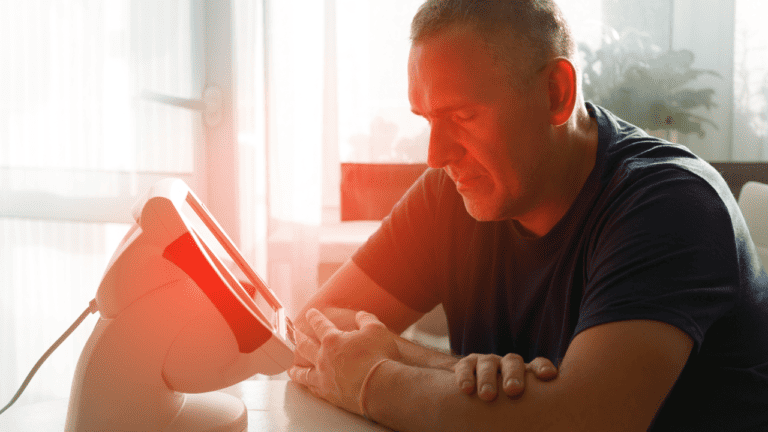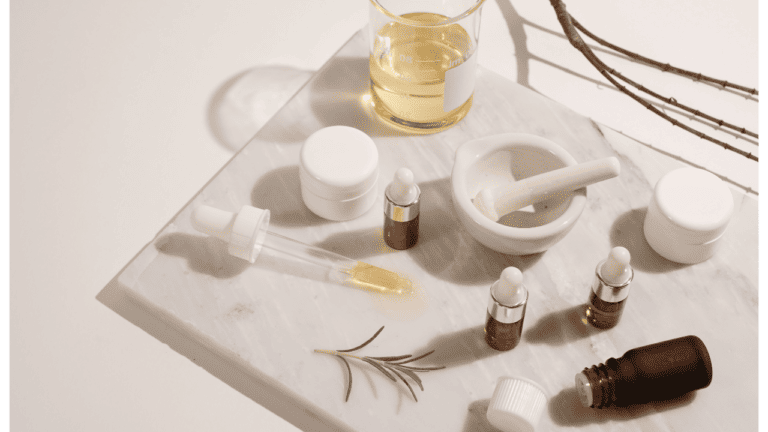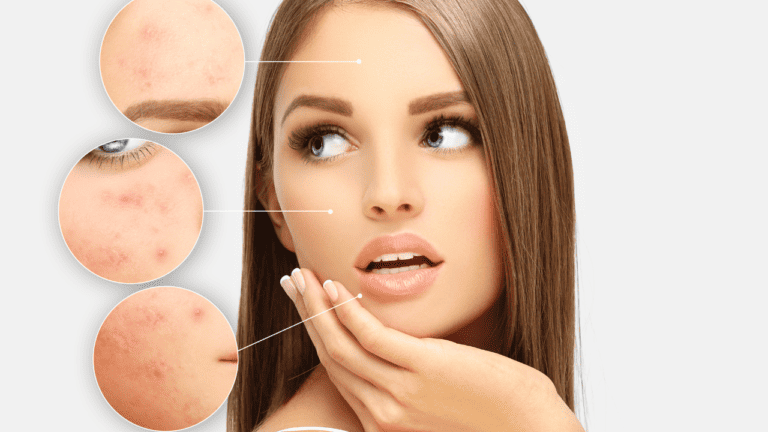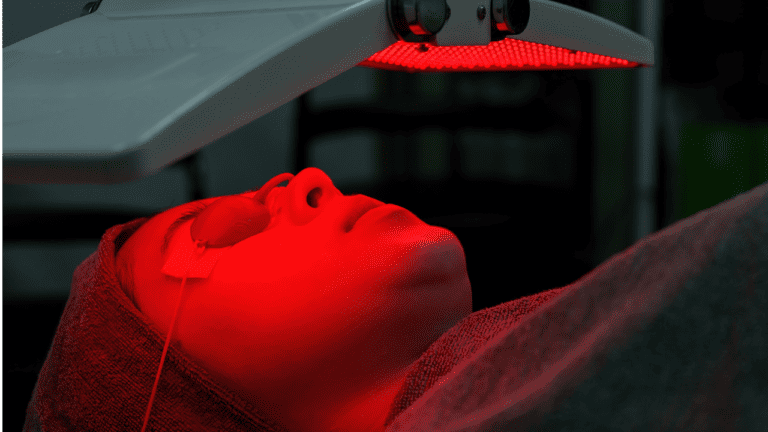High frequency treatment is a form of therapy that has been used to treat various skin conditions, including cystic acne. Cystic acne is a severe form of acne that is characterized by the formation of painful, fluid-filled cysts beneath the skin’s surface. These cysts can be difficult to treat and may cause scarring if left untreated.

High frequency treatment works by using a low-level electrical current to stimulate blood circulation in the treatment area. This increased blood flow can help to reduce inflammation and promote healing, making it an effective treatment option for cystic acne. Additionally, high frequency devices can also help to kill bacteria on the skin’s surface, which can contribute to the development of acne.
Key Takeaways
- High frequency treatment is an effective therapy for treating cystic acne.
- The treatment works by promoting blood circulation and killing bacteria on the skin’s surface.
- High frequency devices can be used both professionally and at home, but it is important to choose the right device and follow proper maintenance and care guidelines.
Understanding Cystic Acne

Cystic acne is a severe form of acne that affects the deeper layers of the skin. It is characterized by large, painful, inflamed cysts that can lead to scarring. This type of acne is more common in teenagers and young adults, but it can occur at any age.
Causes of Acne
Acne is caused by a combination of factors, including excess oil production, inflammation, and bacteria. Hormonal changes, such as those that occur during puberty, pregnancy, or menopause, can also contribute to the development of acne.
In addition, lifestyle factors such as stress, diet, and certain medications can also play a role in the development of acne. For example, consuming a diet high in sugar and processed foods may increase the risk of developing acne.
Characteristics of Cystic Acne
Cystic acne is characterized by deep, painful, inflamed cysts that can be red or purple in color. These cysts can be larger than a quarter and can take weeks or even months to heal. They can also lead to scarring if not treated properly.
Cystic acne can occur anywhere on the body, but it is most commonly found on the face, chest, and back. It can also be accompanied by other types of acne, such as whiteheads and blackheads.
While there is no cure for cystic acne, there are several treatment options available, including topical and oral medications, as well as lifestyle changes. It is important to consult with a dermatologist to determine the best course of treatment for each individual case.
High-Frequency Treatment Overview
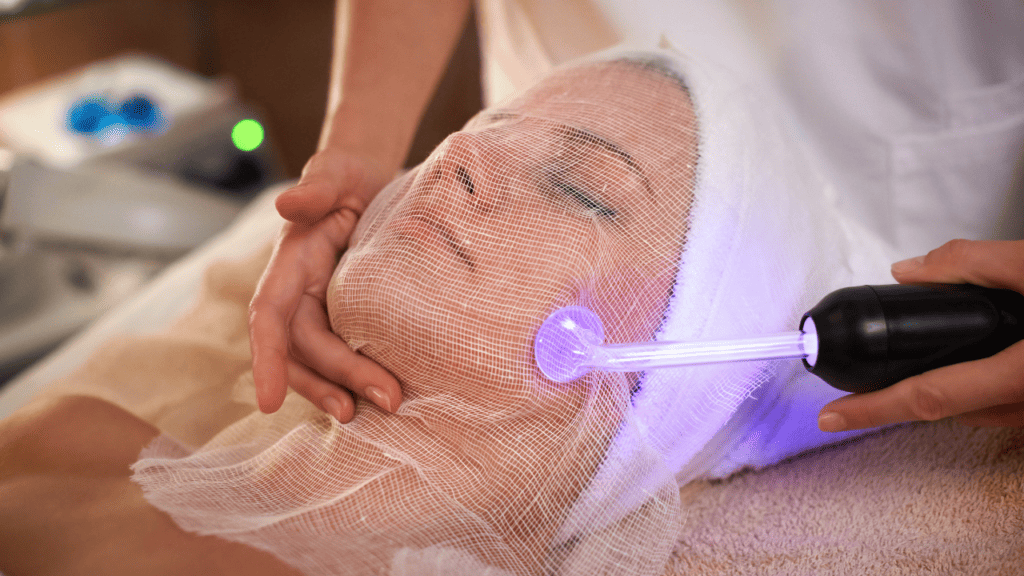
History and Evolution
High-frequency treatments have been used for over a century in the field of medicine. Originally, they were used for wound healing and sterilization. In the 1930s, high-frequency treatments were introduced to the beauty industry as a means of treating acne and other skin conditions.
Over time, high-frequency treatments have evolved to become more effective and efficient. Modern high-frequency machines use argon or neon gas electrodes to produce an electrical current. The electrical current is then applied to the skin, which helps to oxygenate the skin cells and kill bacteria.
How High-Frequency Treatments Work
High-frequency treatments work by producing a mild electrical current that is applied to the skin. This electrical current helps to oxygenate the skin cells, which can improve circulation and promote healing. Additionally, the electrical current can help to kill bacteria on the skin, which can be particularly beneficial for those with cystic acne.
During a high-frequency treatment, the esthetician will apply a conductive gel to the skin and then use a glass electrode to apply the electrical current. The electrode is moved over the skin in a circular motion, and the entire process takes only a few minutes.
Overall, high-frequency treatments are a safe and effective way to improve the appearance of the skin and treat cystic acne. They are non-invasive and do not require any downtime, making them a popular choice for those looking for a quick and easy way to improve their skin.
Benefits of High-Frequency Treatment

High-frequency treatment is a non-invasive therapy that has been used for decades to treat various skin conditions, including cystic acne. It works by emitting a low-level electrical current to the skin, which produces a warming effect that helps to improve circulation and stimulate collagen production.
Acne and Breakout Management
One of the primary benefits of high-frequency treatment is its ability to manage acne and breakouts. The electrical current produced by the device helps to kill acne-causing bacteria and reduce inflammation, which can help to prevent future breakouts. Additionally, high-frequency treatment can help to unclog pores and remove excess oil from the skin, which can also contribute to the development of acne.
Anti-Aging Effects
In addition to its acne-fighting properties, high-frequency treatment also has anti-aging effects. The electrical current produced by the device helps to stimulate collagen production, which can help to reduce the appearance of fine lines and wrinkles. Collagen is a protein that is essential for maintaining healthy, youthful-looking skin, and high-frequency treatment can help to promote its production.
Enhancing Skin Circulation
High-frequency treatment can also help to enhance skin circulation, which can improve the overall health and appearance of the skin. The warming effect produced by the device helps to increase blood flow to the skin, which can help to deliver essential nutrients and oxygen to the skin cells. This can help to improve the skin’s texture, tone, and radiance.
In conclusion, high-frequency treatment is a safe and effective therapy that can help to manage acne, fight the signs of aging, and enhance skin circulation. Its non-invasive nature and ability to stimulate collagen production make it an attractive option for those looking to improve the health and appearance of their skin.
This post may contain affiliate links, which means I’ll receive a commission if you purchase through my link, at no extra cost to you. Please read full disclosure here.
Using High-Frequency Devices
High-frequency devices are becoming increasingly popular as a treatment for cystic acne. They work by using a high-frequency wand that emits low-level electrical currents to kill bacteria on the skin’s surface and reduce inflammation.
NuDerma Portable Handheld High Frequency Skin Therapy Wand Machine w/Neon

Types of High-Frequency Wands
There are two types of high-frequency wands: argon and neon. Argon wands are typically used for oily or acne-prone skin, while neon wands are used for dry or sensitive skin. Some high-frequency wands come with attachments such as a mushroom-shaped electrode, which is used for larger areas of the face, and a pointed electrode, which is used for more precise treatment of individual pimples.
Step-by-Step Usage Guide
To use a high-frequency wand, first, make sure the skin is clean and dry. Then, select the appropriate electrode attachment and plug in the wand. Turn the wand on and adjust the intensity level to a comfortable setting.
Next, place the electrode on the skin and move it in small, circular motions around the affected area for 1-2 minutes. After the treatment, turn off the wand and unplug it.
It is recommended to use the high-frequency wand for 3-5 minutes, twice a week. However, it is important to follow the manufacturer’s instructions and not exceed the recommended usage.
Safety and Precautions
While high-frequency devices are generally safe to use, there are some precautions to keep in mind. Pregnant women should avoid using high-frequency devices, as well as individuals with a pacemaker or heart disease.
It is also important to note that high-frequency devices may not be suitable for all skin types. Those with sensitive skin should start with a lower intensity level and gradually increase as tolerated.
In terms of side effects, some individuals may experience redness, dryness, or a tingling sensation after using a high-frequency wand. These side effects are usually temporary and subside within a few hours.
Overall, high-frequency devices can be an effective treatment for cystic acne. However, it is important to use them correctly and follow all safety precautions to avoid any adverse effects.
Treatment Efficacy and Side Effects
Expected Results
High frequency treatment has been shown to be effective in reducing the severity of cystic acne. This treatment works by killing acne-causing bacteria, reducing inflammation, and stimulating blood circulation. With regular use, patients may see a reduction in redness, swelling, and hyperpigmentation associated with cystic acne. The treatment may also help prevent future breakouts.
Potential Side Effects
While high frequency treatment is generally safe, there are potential side effects to be aware of. Some patients may experience mild discomfort during the treatment, such as tingling or a slight burning sensation. This is usually temporary and should subside shortly after the treatment is completed. However, if the discomfort persists or becomes severe, patients should discontinue the treatment and consult a healthcare professional.
Another potential side effect of high frequency treatment is post-inflammatory hyperpigmentation. This is a condition where the skin becomes darker in the area where the acne was present. While this is usually temporary and will fade over time, it can be a concern for patients who are prone to hyperpigmentation.
Overall, high frequency treatment is a safe and effective option for treating cystic acne. Patients should be aware of the potential side effects and discuss any concerns with their healthcare provider.
Professional vs. At-Home Treatments
When it comes to treating cystic acne with high-frequency devices, patients have the option to either receive in-office treatments from a dermatologist or use an at-home device. Both options have their pros and cons, and it ultimately comes down to the patient’s preference and budget.
In-Office High-Frequency Treatments
In-office high-frequency treatments are performed by a dermatologist or licensed skincare professional. These treatments use a high-frequency device with a glass electrode that emits a low-level electrical current to the skin. The current generates oxygen molecules that kill bacteria and reduce inflammation in the skin.
In-office treatments are generally more powerful than at-home devices and can produce more noticeable results in a shorter amount of time. They are also performed by a professional who can tailor the treatment to the patient’s specific needs and skin type. However, in-office treatments can be costly and time-consuming, requiring multiple appointments over a period of weeks or months.
At-Home High-Frequency Devices
At-home high-frequency devices are becoming increasingly popular as a more affordable and convenient alternative to in-office treatments. These devices are handheld and come with different types of electrodes for treating different areas of the face and body. Some popular at-home high-frequency devices include Skin Gym, NuDerma, and StackedSkincare.
At-home devices are generally less powerful than in-office treatments and may require more frequent use to see results. However, they are more affordable and can be used at the patient’s convenience in the comfort of their own home. Patients should always follow the manufacturer’s instructions and consult with a dermatologist before using an at-home device to ensure it is safe and effective for their skin type and condition.
Complementary Acne Treatments
Cystic acne can be difficult to treat and may require a combination of therapies for optimal results. In addition to medical treatments, complementary acne treatments can help to improve the appearance of the skin and reduce the severity of breakouts.
Topical Treatments
Topical treatments for cystic acne may include cleansers, retinoids, creams, benzoyl peroxide, and salicylic acid. Cleansers can help to remove excess oil and dirt from the skin, while retinoids can help to unclog pores and reduce inflammation. Creams containing benzoyl peroxide and salicylic acid can help to kill bacteria and reduce inflammation, respectively.
Oral Medications
Oral medications may also be used to treat cystic acne. One such medication is spironolactone, which is an anti-androgen that can help to reduce the production of sebum and improve the appearance of the skin. Other oral medications may include antibiotics, isotretinoin, and hormonal therapies.
Lifestyle and Dietary Adjustments
In addition to medical and complementary treatments, lifestyle and dietary adjustments may also be beneficial for those with cystic acne. Eating a healthy diet that is rich in fruits, vegetables, and whole grains can help to reduce inflammation and improve the overall health of the skin. Reducing stress through practices such as meditation or yoga may also be helpful, as stress can exacerbate acne.
It is important to note that while complementary acne treatments can be helpful, they should not be used as a replacement for medical treatments. It is recommended that those with cystic acne consult with a dermatologist to develop a comprehensive treatment plan that addresses their specific needs.
Choosing the Right High-Frequency Device
When it comes to choosing the right high-frequency device for cystic acne treatment, there are various factors to consider. High-frequency devices are affordable skincare tools that can help reduce inflammation, kill bacteria, and promote healing of cystic acne. In this section, we will discuss the factors to consider when choosing the right high-frequency device and recommend some popular brands and models.
Factors to Consider
- Price: High-frequency devices are available at different price points. Some are more affordable than others. It is important to consider your budget and choose a device that fits your needs and budget.
- Effectiveness: Different high-frequency devices may have different levels of effectiveness. Some may work better for certain skin types or acne severities. It is important to choose a device that is effective for your specific condition.
- Safety: Safety is an important factor to consider when choosing a high-frequency device. Make sure to choose a device that is safe and does not cause harm to your skin or health.
- Ease of use: Some high-frequency devices may be easier to use than others. It is important to choose a device that is easy to use and does not require a lot of technical knowledge or skills.
- Brand reputation: It is always a good idea to choose a high-frequency device from a reputable brand that has a good track record of producing quality products.
Recommended Brands and Models
- Skin Gym High Frequency Wand: This is a popular high-frequency device that is affordable and effective for treating cystic acne. It is easy to use and has a good safety record. The Skin Gym High Frequency Wand is a great option for those who are new to high-frequency devices.
- Newway High Frequency Facial Machine: This is a more expensive high-frequency device that is known for its effectiveness in treating cystic acne. It is easy to use and has a good safety record. The Newway High Frequency Facial Machine is a great option for those who are looking for a more advanced high-frequency device.
- TUMAKOU High Frequency Facial Machine: This is another popular high-frequency device that is affordable and effective for treating cystic acne. It is easy to use and has a good safety record. The TUMAKOU High Frequency Facial Machine is a great option for those who are on a budget.
- Pure Daily Care High Frequency Machine: This is a versatile high-frequency device that comes with multiple attachments for different skin concerns. It is affordable and effective for treating cystic acne. The Pure Daily Care High Frequency Machine is a great option for those who are looking for a multi-purpose high-frequency device.
In conclusion, choosing the right high-frequency device for cystic acne treatment requires considering various factors such as price, effectiveness, safety, ease of use, and brand reputation. The recommended brands and models mentioned above are great options to consider based on your specific needs and budget.
Maintenance and Care of Devices
Cleaning and Storage
Proper maintenance and care of high frequency devices are essential to ensure their longevity and effectiveness. One of the most important steps in maintaining these devices is to keep them clean and free of debris. After each use, it is recommended to wipe down the device with a clean, damp cloth to remove any residual product or oil.
For deeper cleaning, the attachment heads can be removed and soaked in a solution of warm water and mild soap for a few minutes. After soaking, the attachment heads should be rinsed thoroughly with clean water and allowed to air dry before reattaching them to the device.
When not in use, the device should be stored in a cool, dry place away from direct sunlight. It is also recommended to store the device in its original packaging or a protective case to prevent damage to the device or its attachment heads.
Troubleshooting Common Issues
High frequency devices are generally reliable and easy to use, but occasionally, issues may arise. Here are some common issues and troubleshooting tips:
-
No power: If the device does not turn on, check to make sure it is properly plugged in. If it is, try using a different outlet or power source. If the device still does not turn on, it may be a problem with the device itself and should be evaluated by a professional.
-
Attachment heads not working: If the attachment heads are not producing the desired effect, make sure they are properly attached to the device. If they are, try cleaning them to remove any debris or buildup. If the problem persists, it may be a problem with the attachment heads themselves and they may need to be replaced.
-
Sparking or arcing: If the device is sparking or arcing, it may be due to a loose or damaged electrode. Check to make sure the electrode is properly attached and not damaged. If it is, the electrode may need to be replaced.
-
Low power: If the device is not producing the desired effect, it may be due to low power. Check to make sure the device is properly plugged in and the power source is functioning correctly. If it is, the device may need to be evaluated by a professional.
In summary, proper maintenance and care of high frequency devices are essential to ensure their longevity and effectiveness. Cleaning the device after each use and storing it properly when not in use can help prevent damage and prolong its lifespan. Additionally, troubleshooting common issues can help ensure the device is functioning correctly and producing the desired effect.
Frequently Asked Questions
How does a high frequency machine help with cystic acne?
A high frequency machine is a device that uses a low-level electrical current to stimulate blood circulation, increase collagen and elastin production, and kill bacteria on the skin’s surface. The machine emits a high frequency current through a glass electrode, which is applied to the skin. The current generates heat, which helps to open up pores, allowing for deeper penetration of skincare products.
When used for cystic acne, the high frequency machine can help to reduce inflammation, kill bacteria, and promote healing. The electrical current helps to oxygenate the skin, which can help to reduce the appearance of cystic acne.
What are the benefits of using a high frequency wand for acne treatment?
There are several benefits to using a high frequency wand for acne treatment. The wand can help to reduce inflammation, kill bacteria, and promote healing. The electrical current generated by the wand helps to oxygenate the skin, which can help to reduce the appearance of acne.
In addition, the wand can help to improve the overall health of the skin. It can stimulate blood circulation, increase collagen and elastin production, and improve the skin’s texture and tone. This can lead to a more youthful, radiant complexion.
Can a high frequency facial wand improve the appearance of acne scars?
While a high frequency facial wand may not completely eliminate acne scars, it can help to improve their appearance. The electrical current generated by the wand can help to stimulate blood circulation and increase collagen and elastin production. This can help to plump up the skin and reduce the appearance of scars.
In addition, the wand can help to reduce inflammation and kill bacteria, which can help to prevent new acne from forming. This can lead to an overall improvement in the appearance of the skin.


